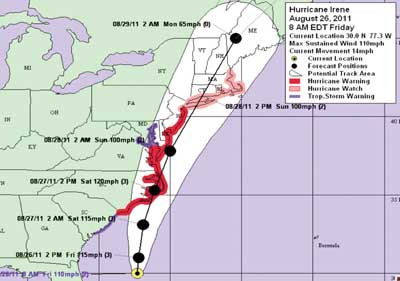
Sandia is trying to anticipate the unexpected to help the nation prepare for severe weather and figure out the best way to lessen the havoc hurricanes and other disasters leave on power grids, bridges, roads, and everything else in their path.
“I think our work in critical infrastructure protection is a really great thing to be working on. We can help provide the understanding and information to help policymakers make good decisions” that result in more resilient infrastructure — meaning it’s better able to absorb impacts and recover quickly, says Marianne Walck, director of Geoscience Climate and Consequence Effects Center 6900.
Marianne was part of a panel in early May at the American Geophysical Union’s inaugural Science Policy Conference aimed at highlighting geoscience insights for the economy, public safety, and national security. She discussed Sandia’s work in developing ways to assess the resiliency of the nation’s infrastructure and in providing the knowledge officials need to create more resilient systems.
Sandia is trying to make the effort more quantitative by developing a mathematically rigorous approach to assess resilience objectively, says manager Lori Parrott (6924). As a part of critical infrastructure protection programs funded by DOE, the US Department of Homeland Security (DHS), Sandia’s Laboratory Directed Research and Development program, and agencies such as the Federal Emergency Management Agency (FEMA), Sandia has developed capabilities ranging from high-fidelity models of individual infrastructure elements to generic network models and dynamic simulations.
Sandia’s expertise in interdependencies and system modeling, economic and human consequences, asset and facility modeling, and integrating simulation architectures allows analysts to provide information on complex systems to decision-makers, Lori says.
“The analytic information can allow policymakers to be better informed to decide how to craft policies, how to promote incentives to create resilient infrastructure, or how to prioritize recovery and restoration,” she says. “It’s a true example of leveraging federal investments in Sandia capabilities to support multiple agencies’ missions.”
Researchers do a risk analysis and quantify uncertainties. They look at interdependencies among systems and supply chains, the resilience of various systems, how infrastructure systems fail, any cascading effects, and how results might differ if there are a series of disasters instead of just one.
Good models allow analysts to quantify consequences of disruptions in very complex systems. “If you don’t have a good model to look at or to exercise in terms of running through these various scenarios, you may not understand what could really happen,” Marianne says.
A flood, for example, could damage roads, collapse bridges, and take down power lines, leaving officials to decide how best to rebuild and how much that will cost, Marianne says.
“This isn’t just saying, ‘Oh, I think that hurricane is going to knock out this particular chemical plant.’ Then you have to think about what that means in terms of getting critical chemicals to industries. What societal or economic effects will result if this particular product isn’t supplied? There are lots of different interactions that go on,” she says. “It’s just illuminating to understand what the impacts are if you’ve got particular types of infrastructure.”
Understanding impacts
Efforts to analyze natural disasters and other threats grew out of Sandia’s strengths in systems engineering and complex systems analysis, she says. Some of the work is done through the National Infrastructure Simulation and Analysis Center (NISAC), a DHS program housed at Sandia and Los Alamos national laboratories. NISAC models and analyzes critical infrastructure, including how interdependent and vulnerable systems may be and the consequences of having them disrupted.
“Given how much of our national and economic security rests on the resiliency of our infrastructure, the rational choice for policy-makers is to experiment with models, not the system,” Lori says.
Each year, NISAC undertakes projects to analyze various risks. Given a particular incident, how could people be evacuated given a particular road system? How much damage would hurricane-force winds cause to power lines, and would that cause governments to consider requiring underground lines in the future? There also are rebuilding considerations. Would it be better, for example, to focus on repairing rail transportation routes in a particular area rather than try to repair all routes simultaneously?
NISAC has developed expertise in analyzing subjects and developing models based on that analysis that cover everything from national transportation to interdependent supply chains. “Through our long-term analysis projects and our capability development, we work to keep our data, models, and analytic expertise current to be useful for crisis decision support,” Lori says.
For example, NISAC has worked on a number of hurricanes, including Hurricane Irene, the only hurricane to threaten the US mainland last year. Although a small storm compared to other hurricanes, Irene was unusual. Rather than striking a concentrated area, Irene traveled up the East Coast, threatening a large swath of significant infrastructure.
Officials asked NISAC to analyze Irene’s likely impacts while the storm moved toward shore and to deliver an analysis in less than 12 hours. NISAC came through, and Marianne says its analysis was used to brief FEMA and first responders as well as the DHS and DOE.